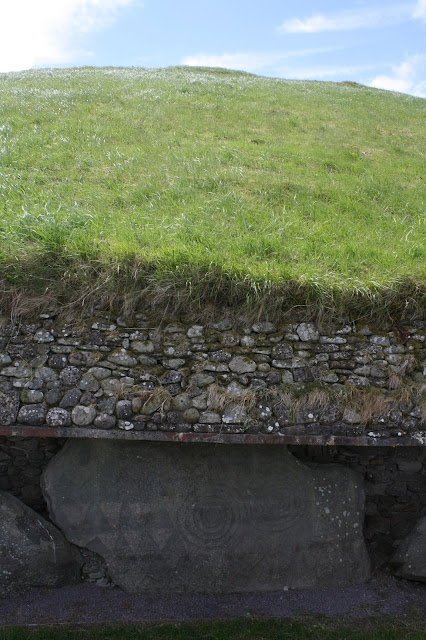Newgrange, Brú na Bóinne. Panorama by Renée Mertz/Joshua Albers, May 24, 2013.
After the tour of Knowth, our little group of eight-ish piled into the van and headed back to the rendezvous lot, where we would transfer to another vehicle bound for Newgrange. While the group to Knowth hardly filled a fourth of the van that carried us there, the group to Newgrange could barely fit into two of the same large buses. This disparity in popularity is emblematic of the sites’ relative fame. Between its gleaming wall of quartz and re-enactment of the winter solstice, Newgrange nearly sparkles with tourist readiness and appeal, but loses the intimacy and relative freedom offered by its older neighbor.
Reconstructed quartz and granite retaining wall, Newgrange.
The site consists of a solitary great mound, although smaller satellite graves are visible in the fields across the road.
Small satellite mounds across the road from Newgrange.
Unlike the primary mounds at both Knowth and Dowth, the tomb at Newgrange contains just one chambered passage, which visitors may enter as part of a guided group. Photography is not allowed inside the tomb, but professional images are readily available on the web, including World Heritage Ireland's official website.
Newgrange’s interior provides a sense of what the similarly chambered “female” passage at Knowth must have looked like before later changes made it largely impassible. The long narrow tunnel is lined with decorated slate standing stones and opens into a wider room bordered by three niches which once contained cremated remains and burial offerings. The original corbelled ceiling stands intact at a height of about 20 feet.
Entrance to the Newgrange passage with decorated kerbstone and roof box.
But perhaps Newgrange’s most impressive feature is the play of light that occurs on the winter solstice. From outside, a second, smaller opening is visible above the entrance. Due to the gradual upward slope of the interior passage, this same opening is actually parallel to the floor of the chambered room. Normally this relationship is imperceptible, and the chamber—at least when empty of tourists—remains pitch black. However, for a few days around the winter solstice a beam of light finds its way through the upper passage and falls across the northern niche, lighting the room for a few brief minutes at sunrise. The site offers a lottery each year to allow a small number of visitors the opportunity to experience this phenomenon in person. For those of us not lucky enough to be among the chosen, the tour recreates an abbreviated but still impressive version using artificial light.
Decorated kerbstones, Newgrange.
Outside, Newgrange offers a small number of intricately decorated and well-preserved kerbstones. Chief among these is the impressive (and well photographed) entrance stone. Entrance stones are common features of passage tombs, and tend to be large enough to make entry difficult but not impossible. They were probably intended to demarcate the boundary of the tomb, signifying the divide between the dead and the living, the sacred and the profane.
View of Knowth.
All photographs by Renée Mertz unless otherwise stated, May 24, 2013.














How fantastic it would be to be among the chosen for winter solstice! But then, there's always Cahokia, IL, which is a lot closer!
ReplyDelete